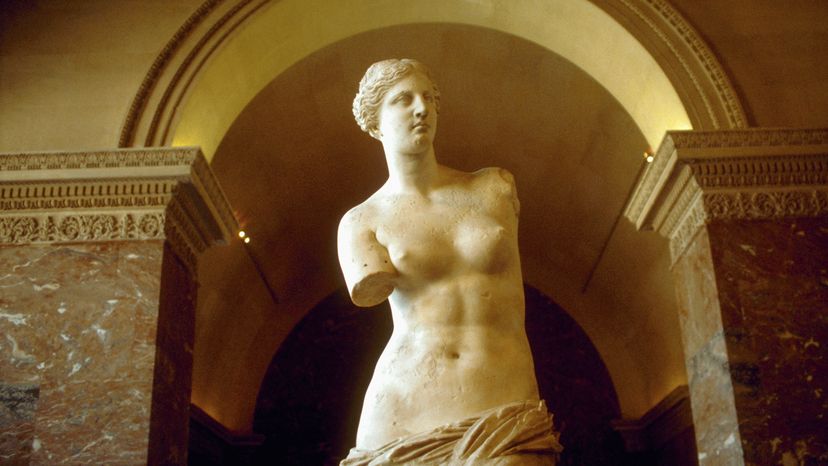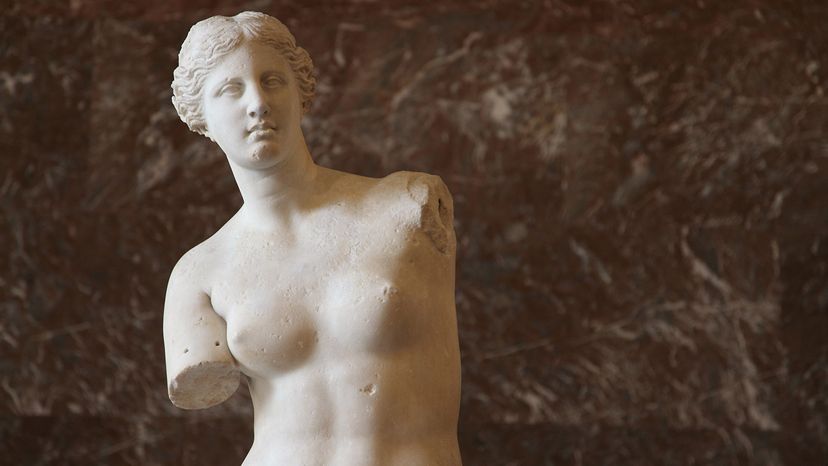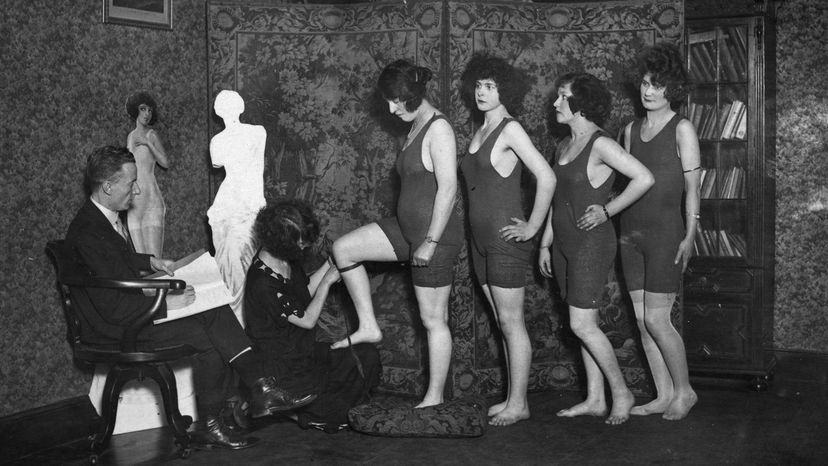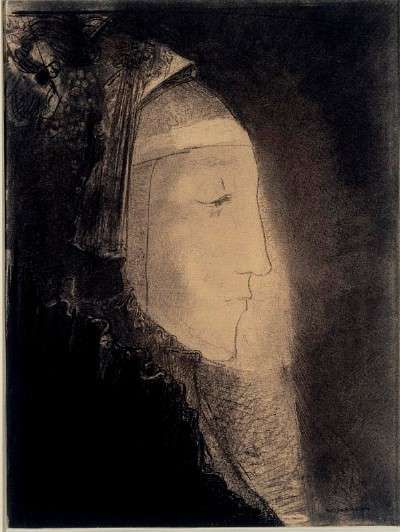
She's one of the most recognizable figures in the art world, but shrouded in mystery. Ever since Louis XVIII donated her to the Louvre in 1821, she's captured the attention and praise of audiences and historians, but many are still baffled by her origins — who is Venus de Milo, and what exactly happened to her arms?
The half-naked marble goddess many of us know as Venus de Milo actually likely represents two figures who are not Venus, the Roman goddess of love, sex, beauty and fertility. The statue is thought to represent either Aphrodite, Venus's Greek counterpart, or Amphitrite, the goddess-queen of the sea and wife of Poseidon. But when the statue was discovered in 1820 on the Greek island of Melos (Milos in modern Greek) and presented to Louis (who in turn donated her to the Louvre), no one was quite sure what to make of her.
Advertisement
"When the Louvre acquired the statue in 1820, the British Museum had just acquired the Elgin Marbles (1816), universally attributed to the fifth-century B.C.E. sculptor Pheidias, generally acknowledged by ancients and moderns as the greatest of Greek sculptors," Andrew Stewart, Nicholas C. Petris Professor of Greek Studies Emeritus at UC Berkeley, says via email. "Moreover, the Louvre and in turn, French art as a whole, had just suffered huge losses when in 1815-1818 Napoleon's looted art collection was returned to its countries of origin. The museum lost some of its most iconic pieces, such as the Vatican Laocoön and Florence's Venus de Medici. So national pride needed to be restored, and the Venus de Milo (properly, 'Aphrodite,' since she's Greek) was literally a godsend."
But because of the statue's unique attributes, experts had some trouble identifying her origins. "Since she was obviously later stylistically, but still classical, she was immediately attributed to Praxiteles, the greatest fourth-century B.C.E. sculptor and universally acknowledged master of the female nude, epitomized by the love-goddess Aphrodite. A base found with her signed by the sculptor [Alex]andros of Magnesia on the Meander (a city not founded until the third century B.C.E.), was thus immediately and conveniently lost."
According to Stewart, German archaeologist Adolf Furtwängler is credited with discovering Venus de Milo's true roots as a Greek neoclassical statue, not a classical one, but the revelation didn't come until the late 19th century when he realized that her drapery was clearly Hellenistic and probably created in the second century B.C.E. Despite her authentic identity, the statue is still often tied to an older era. "She still is regarded as a masterpiece of the [classical] genre, partly because we have so few originals of her size, state of preservation and quality," Stewart says.
While the Louvre website describes the statue as "shrouded in mystery," some details of her original appearance are known. For one thing, she originally wore metal jewelry including a bracelet, earrings, and headband, since there are fixation holes remaining in all those areas on her body. The marble that she's carved from may have been embellished with polychromy that's now faded. And at some point, she did, in fact have arms — but they were never found.

"The right arm is broken away: its hand originally grasped the top of her drapery," Stewart says. "The bust, legs, left arm, foot, base and herm [an archaic bearded head of the god mounted on a square-section stone pillar] socketed into the base, were carved separately, and doweled on with iron dowels set in lead: a common technique."
Stewart says that at the end of antiquity (a time period that signifies the transition from the Greco-Roman period to the Middle Ages), someone removed Venus' limbs in order to take the metal dowels and recycle them. "The best bet, in my opinion, is that she held an apple in her outstretched left hand, which would have rested on the herm," he says. "Such an arm was found in a nearby niche, and is represented in a 19th century drawing in the Louvre. The apple would be both her personal accessory or attribute (her token prize at the "Judgment of Paris") and a pun on the name of the island, since the Greek for apple is μήλον (mēlon), and apples feature prominently on Hellenistic Melian coins."
The "Judgment of Paris" is an important Greek myth that's central to Venus' meaning and describes a contest between three goddesses — Aphrodite, Hera and Athena — for the prize of a golden apple addressed "To the Fairest." In his book, "Art in the Hellenistic World: An Introduction," Stewart describes the Venus de Milo's many symbolic ties. He writes, "Dedicated to the gods of the gymnasium in which she was found, she would have symbolized the ties of affection (erôs) that united the Melians who exercised there. Moreover, Greeks had long understood the 'Judgment of Paris' as symbolizing a man's three principal life choices: war (Athena), politics (Hera) or love (Aphrodite)." Stewart says that because the Romans were now largely engaged in war and politics, the third category — love, marriage and domesticity — "had become increasingly attractive." According to Stewart, Venus's multidimensional appeal "would have created the sense of an in-group among the gymnasium's clientele, satisfying at one stroke the demands of local piety and this culture's overriding desire to connect."
But according to Elizabeth Wayland Barber, professor emerita of archaeology and linguistics at Occidental College and author of "Women's Work: The First 20,000 Years Women, Cloth, and Society in Early Times," Venus's missing arms were very much engaged in a different, meaningful domestic activity. "While studying the origin and development of textiles in the Eastern Hemisphere (we now have evidence there for humans spinning thread or yarn back more than 50,000 years, and weaving back 25,000 years), I found copious evidence that women were always doing most or all of the textile-related work," Barber says via email. "The Venus de Milo is in exactly the position used at that time and place for spinning thread — the part of the job that took the most time, so women were spinning every moment they could find."

Barber says that although the statue's arms are long gone, the musculature sculpted in her shoulders and upper back suggest they were raised in just the position required for spinning, and her eyes are focused on the exact spot one would have to watch as they spun. "Also, Aphrodite (aka Venus) was viewed by the Greeks as the goddess of spinning as well as of procreation," Barber says. "But the two are closely linked, both by the umbilical cord attached to the new baby, and by the fact that, in both spinning and baby-making, you start with a formless blob and create something remarkable out of it, seemingly by magic." In Barber's book, there's even an illustration of the Venus de Milo reconstructed as spinning.)
While experts hold varying theories over Venus de Milo's original activities, many are in agreement that she continues to be one of the most fascinating, albeit puzzling, products of the Hellenistic Period. And as The Guardian's Jonathan Jones wrote in 2015, "The Venus de Milo is an accidental surrealist masterpiece. Her lack of arms makes her strange and dreamlike. She is perfect but imperfect, beautiful but broken — the body as a ruin. That sense of enigmatic incompleteness has transformed an ancient work of art into a modern one."
HowStuffWorks may earn a small commission from affiliate links in this article.
Advertisement

